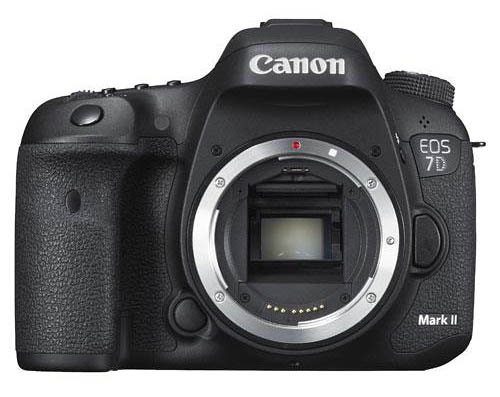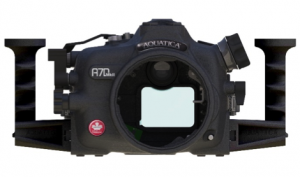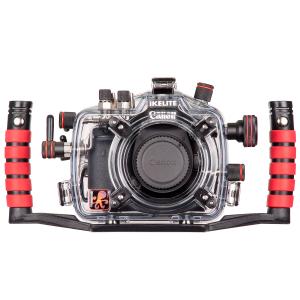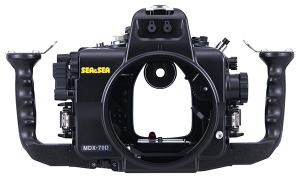Review: Canon 7D Mark II for Underwater Photography

We're starting to see the first underwater housings for the new Canon 7D Mark II - the perfect time to write our in-depth review of the camera. The long-awaited 7D Mark II is a great camera with some major upgrades over the original 7D. But how will it perform for underwater photo and video?
The Canon 7D Mark II has many upgrades you would expect: a 20.2MP APS-C CMOS sensor, faster processers, higher frames per second burst, increased ISO capabilities, intervalometer (finally, Canon!) and even a new battery.
A major upgrade, and perhaps best reason to purchase this camera for underwater use, is the new Dual-Pixel CMOS AF first released in the Canon 70D. This sensor technology allows the camera to use phase detection and contrast detection AF in the Live View mode (most DLRs rely only on contrast in Live View, which is why that AF is slow and unreliable for video, especially underwater). Long story short, the Dual-Pixel AF opens new possibilities for using autofocus when recording video.
The 7D Mark 2 also makes big improvements for shooting with higher ISOs, as this technology is changing fast in the digital camera world. While not important for underwater photos with strobes, the higher ISO capabilities will be welcome for videographers, who can push the ISO higher before image quality becomes an issue.
We'll explore these 7D Mark II features in this review and compare the camera with other DSLRs in the same class.
Jump to Review Section:
Canon 7D Mark II Key Specifications
20.2MP APS-C Sensor
Dual-Pixel CMOS AF
Dual Digic 6 Processors
1080p/720p video both with 60fps (30fps with All-I)
Servo AF for video shooting
65 Point "All Cross-Type" Autofocus
10 FPS
ISO 100-16000
CF & SD Card Slots
Built-in Flash
GPS (no wifi)
New, larger capacity battery
MSRP: $1,799 USD
Highlights for Underwater Use
Most advanced autofocus system in its class, including for video
Built-in flash allows you to use fiber optic cables instead of sync cords
High ISO performance allows for more creativity in shooting underwater video
Excellent camera for topside use as well. Use EF-S and EF mount lenses

Body and Controls
The Canon 7D Mark II is a semi-pro DSLR and the magnesium alloy body feels that way in your hands. The button layout is similar to the original 7D but mirrors the Canon 5D Mark III exactly. The only addition in this body is an AF Area Selection Lever built around the Multi-controller pad. This allows you to change the AF area with a flick of the thumb instead of the M-FN button above the shutter button.
I've owned several Canon bodies including the original 7D, and currently take two 5D Mark IIIs on every dive trip. I love the layout of the camera. The grip is deep enough to wrap my fingers around and enough to loosely hold the camera at your side in between topside shots. It has great balance with lens attached.
All the shooting controls are easily accessed with thumb and trigger finger for quick changes, while your left thumb controls the display, image review functions and the menu button that are generally used when the camera is away from your face.
Below are some highlights:
The camera/movie switch is located the the right of the viewfinder, so it's out of the way but easy to access.
The AF-ON button (used by some for back-button focus) is ergonomically placed for thumb access.
The Quick Control button once again provides quick access to settings otherwise reached through the main menu (i.e. exposure compensation and custom controls)
Dual card slots allow you to shoot with either a CF or SD card. You can use both slots to expand capacity, record images onto two cards (backup purposes) or even shoot RAW on one card and JPG on another. Note that when two cards are in the camera, the write speed to the cards will slow down when shooting bursts. Two cards is also nice with Magic Lantern, but note that we don't recommend installing 3rd party software on your camera.
Another upgrade in the Canon 7D Mark 2 is the improved weather sealing. Canon has made this workhorse camera into even more of a "beast" with new seals and gaskets at important points. This is not only important for shooting in the rain, but also for divers traveling to humid climates. I recently had a wave crash over my 5D with no issues. Canon makes tough cameras and the 7D Mark II promises to deliver in this area as well.
We'll be testing housing ergonomics in upcoming reviews.


Full Frame or Crop Sensor?
Most underwater DSLR shooters will opt for a crop sensor, as the areas in which they excel deliver tangible benefits over full frame sensors. Here's a quick breakdown:
Pros of a Crop Sensor
Cheaper than full frame camera body.
The standard 1.6 crop factor (1.5 on Nikon DX) essentially magnifies the image, bringing you closer to that shark swimming in the distance or filling the frame with a small nudibranch.
You can use a lower aperture to achieve the same depth of field as a higher aperture on a full frame sensor. This is beneficial for three reasons:
Most lenses deliver their best image quality in mid-range apertures.
Higher apertures become prone to diffraction.
Lower apertures allow more light to hit the sensor, which helps bring more vibrant color from video lights (when shooting video), while maintaining necessary depth of field for the shot.
Pros of a Full Frame Sensor
Larger sensor is more sensitive to light.
Better performance at high ISOs, specifically with electronic noise and color.
Less depth of field at the same apertures results in smoother bokeh.
7D Mark II Best Lenses for Underwater Use
The Canon 7D Mark II is a crop sensor (APS-C) and uses Canon's EF-S and EF lenses plus compatible 3rd party lenses. Underwater photography generally falls into two categories, wide-angle and macro. The lenses below are best for shooting in these styles with the Canon 7D Mark II (and all Canon APS-C DSLR bodies).
Canon EF-S 60mm f/2.8 Macro USM
This lens is the first lens for underwater macro photographers, with a very close focus distance to subjects. The 60mm is also much easier to use than the 100mm mentioned below, making it ideal for those without experience shooting underwater macro with DSLRs.
Canon EF 100mm f/2.8L Macro IS USM
This smooth and fast lens should be in every experienced (Canon) underwater photographer's bag. It provides the magnification needed for shooting small macro subjects and the tiniest subjects when combined with a diopter on the outside of the housing port. View some photos shot with this Canon 100mm Macro Lens.
Tokina 10-17mm f/3.5-4.5 AT-X DX Fisheye Zoom
This Tokina fisheye lens is heralded as the best lens for shooting reefscapes, big animals, divers and more. It provides the best image quality on crop sensors. Make sure to get the Canon version and not the Nikon version, as these are different mounts. Read our review of the Tokina 10-17mm Fisheye Lens.
Mid-Range Zoom Lenses
Divers who will be shooting sharks, whales or other objects that may be further away with opt for a mid-range zoom lens like the Canon 10-22mm, Sigma 10-20mm or Tokina 11-17mm. Many divers also use the Sigma 17-70mm OSM HSM for it's great flexibility between wide-angle and macro.
7D Mark II Sensor and Image Quality
Performance at High ISO
There is much focus on high ISO performance with DSLRs these days. ISO is the light sensitivity of your digital camera's sensor, and the third element of the image exposure equation. In bright outdoor shooting, a low ISO (i.e. 100) is used, however darker situations (i.e. indoors) require higher ISOs in order to maintain a shutter speed fast enough to minimize camera shake. High ISO performance is important because as the ISO increases, the amount of digital noise, or grain, in the image increases, which decreases the imaze quality.
For underwater photography, we generally use low ISOs since we light the scene with powerful strobes.
For underwater video, however, ISO becomes much more important since your shutter speed is locked and certain apertures need to be maintained for proper depth of field.
Below are sample photos showing the Canon 7D Mark II's high ISO performance.

RAW image.
All crops below are unprocessed except for Lightroom's default sharpening for screen.

ISO 800, 100% crop (note small motion blur from hand-holding 1/160s at 70mm)

ISO 1600, 100% crop

ISO 3200, 100% crop

ISO 6400, 100% crop

ISO 12800, 100% crop
DxOMark Sensor Rating
Let's geek out a second. DxOMark is a group that provides independent image quality measurements and comparisons via RAW file. For this and the next section of the review we'll look at sensor measurements for the 7D Mk2.
Canon 7D Mark II
Overall Score: 70
(Canon 70D: 68, Canon 5DMkIII: 81, Nikon D7100: 83)
Portrait (color depth): 22.4 bits
(Canon 70D: 22.5 bits, Canon 5DMkIII: 24 bits, Nikon D7100: 24.2 bits)
Landscape (dynamic range): 11.8 Evs
(Canon 70D: 11.6 Evs, Canon 5DMkIII: 11.7 Evs, Nikon D7100: 13.7 Evs)
Sports (low-light ISO): 1082 ISO
(Canon 70D: 926 ISO, Canon 5DMkIII: 2293 ISO, Nikon D7100: 1256 ISO)
Source: DxOMark.com
What Does This Mean for Underwater Photography and Video?
The DxOMark scores above must also be interpreted with proper context. Let's go through color depth and dynamic range:
Color Depth: Color sensitivity of 22 bits is excellent, and differences below 1 bit are barely noticeable. The 7D Mark II is rated as excellent - on par with the 70D and below the 5D MkIII and D7100.
Dynamic Range: A value of 12 Ev is excellent, with differences of 0.5 Ev usually not noticeable. The Canon camp sits less than 0.5 Ev below this mark and so earns the excellent rank, while the D7100 excels.
Source: DxOMark.com
This must all be taken with a grain of salt. True, Nikon sensors (actually made by Sony) rank higher in performance with DxOMark, but the sensor is only one small piece of the image-making equation.
Canon 7D Mark II Spec Comparison
| Canon 70D | Canon 7D Mk II | Canon 5D Mk III | Nikon D7100 | |
| Sensor | 20.2MP APS-C | 20.2MP APS-C | 22MP Full Frame | 24.1MP DX |
| Processor | DIGIC 5+ | Dual DIGIC 6 | DIGIC 5+ | EXPEED 3 |
| AutoFocus | 19 point AF, all cross-type dual-pixel | 65 point AF, all cross-type dual-pixel, center double-cross | 61 point AF, 41 cross-type, center double cross | 51 point AF, 15 cross-type |
| Video AF | Phase & contrast hybrid | Phase & contrast hybrid | Contrast detection | Contrast detection |
| Video Framerate | 1080p/30, H.264 | 1080p/30, H.264 | 1080p/30, H.264 | 1080p/30, H.264 |
| FPS | 7 FPS | 10 FPS | 6 FPS | 6 FPS |
| Max Shutter Sync | 1/250s | 1/250s | 1/200s | 1/250s |
| Bullt-in Flash | Yes | Yes | No | Yes |
| Storage | 1 slot: SD, SDHC, SDXC | 2 slots: CF, SD, SDHC, SDXC | 2 slots: CF, SD, SDHC, SDXC | 2 slots: SD, SDHC, SDXC |
| Weight | 755g | 910g | 950g | 765g |
Canon 7D Mark II vs:
Canon 70D:
While the sensor measurements are comparable, the 7D Mark II offers slightly better high ISO performance. It also has a much more sophisticated AF system and shoots more frames per second - great for fast action.
Canon 5D Mark III:
The 7D Mark II is the much cheaper option, and offers the benefits of a crop sensor (see Full Frame or Crop Sensor? section above).
Nikon D7100:
The 7D Mark II offers much better autofocus and FPS than the D7100. AF in movie mode is also superior. And while the D7100's sensor may technically be better, there are many other differences to consider. For example, do you prefer the color recorded Nikon or Canon RAW files? Do you prefer the menus, buttons and ergonomics of the 7D MkII over the D7100?
Most importantly, can you see the differences between these camera models in photos online, printed in magazines or anywhere else you'll be sharing your images? I'm a Canon shooter, so for me the decision between the 7D Mark II and D7100 is a no-brainer. A Nikon shooter will likely prefer the D7100, hands down.
Wide-Angle Tests Underwater
The Canon 7D Mark II is a great camera for underwater wide-angle photography. I tested it in the Ikelite 7D MkII housing with the Tokina 10-17mm fisheye lens. While conditions were not ideal on the wide-angle dive, I was able to shoot some traditional wide shots as well as some close focus wide-angle, both delivering nice results.
The 7D Mark II's autofocus performs well for wide-angle - tracking and locking onto moving targets like fish and swaying sea palms.

A female sheephead inspects herself in the Ikelite 8" dome port. Shot with Canon 7D Mark II and Tokina 10-17mm fisheye lens.

A horn shark poses for a photo on a typical Malibu reef. Shot with Canon 7D Mark II and Tokina 10-17mm fisheye lens.
Purple hydrocoral and gorgonian at Farnsworth Bank, Catalina Island. Shot on a different day for our review of the Nauticam 7D Mark II housing with the Tokina 10-17mm fisheye lens.
A garibaldi greets the camera at Eagle's Nest, Catalina Island. Shot on a different day for our review of the Nauticam 7D Mark II housing with the Tokina 10-17mm fisheye lens.
Macro Tests Underwater
I made two macro dives with the 7D Mark II for this review, both with the Ikelite housing and Canon 100mm f2.8L macro lens. This camera and lens combo delivers sharp images with nice color and contrast, even at 100% zoom.
Autofocus works nicely here as well, both with static subjects as well as tracking moving subjects like the eyes of passing fish. The 100mm lens delivers nice bokeh with the 7D Mark II.

A spanish shawl nudibranch lays eggs. Shot with Canon 7D Mark II and Canon 100mm macro lens.

Sharp detail on a California spiny lobster. Shot with Canon 7D Mark II and Canon 100mm macro lens.

This hermissenda nudibranch stands out even without the use of a black background. Shot with Canon 7D Mark II and Canon 100mm macro lens.

Corynactis with urchin spines in the foreground. Shot with Canon 7D Mark II and Canon 100mm macro lens.

Beautiful color and sharp detail in a kelp bass. Shot with Canon 7D Mark II and Canon 100mm macro lens.

The 7D Mark II's autofocus had no trouble tracking the eye of this passing sheephead. Shot with Canon 7D Mark II and Canon 100mm macro lens.
Underwater Video
Shooting underwater video with the 7D Mark II is a pleasure. Canon's dual-pixel CMOS autofocus is super fast when using Live View. You can tell immediately that phase detection is being used to achieve focus instead of just contrast detection like other DSLR Live View modes (which focus by hunting back and forth).
Older Live View AF systems (like in my Canon 5D Mark III) generally take a long time for focus to shift after you recompose a shot - even with a half depress of the shutter, and especially in low light underwater. With the 7D Mark II, Servo AF quickly shifts to your new subject when recomposing, and is very fast when aiding it with half depress. Depending on your shot, the dual-pixel AF may work well enough for a shifting AF on slow pan shots since it is so much smoother.
The Movie Servo AF has three different modes (L+(face) Tracking, FlexiZone - Multi and FlexiZone - Single) that allow you to fine-tune the autofocus for your shot. The L+ tracking is designed for tracking human faces, so I like to use FlexiZone - Multi for full autofocus (wide scenes) and FlexiZone - Single for shots that have a strong subject, moving the focus point onto that subject. Just remember that using AF for video does give control to the camera, which might not be as creative or anticipative as you. For example, I was drifting over a group of gorgonians and the last one was much taller than the rest. As I passed over it, the AF adjusted for the close gorgonian instead of staying where it had been, and once I passed it into blue water with lots of fish life, they were all out of focus for a second while the camera adjusted back to the longer distance between subject(s) and lens. There went that shot.
Adjusting basic camera settings in video mode (ISO, aperture, shutter speed) will depend on the individual housing ergonomics, but all housings will allow access to the Quick settings menu when shooting in Live View. For underwater video, this is most used for changing the AF Method.
7D Mark II Best Settings and Menu Breakdown
Be sure to read our companion article for wide-angle, macro and video settings, plus a full breakdown of the camera menu:
Canon 7D Mark II Best Settings for Underwater.
Underwater Housing Options
Nauticam Canon 7D Mark II Underwater Housing
The Nauticam housing features great ergonomic controls, quick release port lock system and vacuum pump leak detect system.
See Nauticam Canon 7D Mark II housing recommended lenses and ports on Bluewater Photo.
Read our Nauticam 7D Mark II housing review.
Aquatica Canon 7D Mark II Underwater Housing
The Aquatica housing is precision-made with performance that lasts , wide range of ports and vacuum pump leak detect system.
See the Aquatica Canon 7D Mark II housing recommended lenses and ports on Bluewater Photo.
Ikelite Canon 7D Mark II Underwater Housing
The polycarbonate Ikelite housing offers the best performance to dollar ratio for housing the 7D Mark II, with nice controls, great port selection to get every shot and vacuum pump leak detect system.
See the Ikelite Canon 7D Mark II housing recommended lenses and ports on Bluewater Photo.
Read our detailed Ikelite Canon 7D Mark II housing review.
Sea & Sea Canon 7D Mark II Underwater Housing
The Sea & Sea housing is engineered for great housing control, with a great port selection and vacuum pump leak detect system.
See the Sea & Sea Canon 7D Mark II housing recommended lenses and ports on Bluewater Photo.

Third frame shot with the 7D Mark II out of the box.

Subtle pre-dawn color with the 7D Mark II.
Additional 7D Mk II Underwater Photos




Further Reading
RECOMMENDED ARTICLES
SUPPORT THE UNDERWATER PHOTOGRAPHY GUIDE:
The Best Service & Prices on u/w Photo Gear
 Visit Bluewater Photo & Video for all your underwater photography and video gear. Click, or call the team at (310) 633-5052 for expert advice!
Visit Bluewater Photo & Video for all your underwater photography and video gear. Click, or call the team at (310) 633-5052 for expert advice!
The Best Pricing, Service & Expert Advice to Book your Dive Trips
 Bluewater Travel is your full-service scuba travel agency. Let our expert advisers plan and book your next dive vacation. Run by divers, for divers.
Bluewater Travel is your full-service scuba travel agency. Let our expert advisers plan and book your next dive vacation. Run by divers, for divers.








































